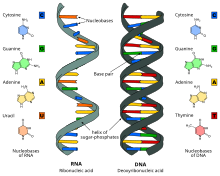
Back حمض نووي Arabic الاحماض النوويه ARZ Ácidu nucleico AST Nuklein turşuları Azerbaijani Нуклеин кислоталары Bashkir Nukleyikong asido BCL Нуклеінавыя кіслоты Byelorussian Нуклійныя кісьлі BE-X-OLD Нуклеинова киселина Bulgarian নিউক্লিক অ্যাসিড Bengali/Bangla

Nucleic acids are large biomolecules that are crucial in all cells and viruses.[1] They are composed of nucleotides, which are the monomer components: a 5-carbon sugar, a phosphate group and a nitrogenous base. The two main classes of nucleic acids are deoxyribonucleic acid (DNA) and ribonucleic acid (RNA). If the sugar is ribose, the polymer is RNA; if the sugar is deoxyribose, a variant of ribose, the polymer is DNA.
Nucleic acids are chemical compounds that are found in nature. They carry information in cells and make up genetic material. These acids are very common in all living things, where they create, encode, and store information in every living cell of every life-form on Earth. In turn, they send and express that information inside and outside the cell nucleus. From the inner workings of the cell to the young of a living thing, they contain and provide information via the nucleic acid sequence. This gives the RNA and DNA their unmistakable 'ladder-step' order of nucleotides within their molecules. Both play a crucial role in directing protein synthesis.
Strings of nucleotides are bonded to form spiraling backbones and assembled into chains of bases or base-pairs selected from the five primary, or canonical, nucleobases. RNA usually forms a chain of single bases, whereas DNA forms a chain of base pairs. The bases found in RNA and DNA are: adenine, cytosine, guanine, thymine, and uracil. Thymine occurs only in DNA and uracil only in RNA. Using amino acids and protein synthesis,[2] the specific sequence in DNA of these nucleobase-pairs helps to keep and send coded instructions as genes. In RNA, base-pair sequencing helps to make new proteins that determine most chemical processes of all life forms.
- ^ "Nucleic Acid". Genome.gov. Retrieved 1 January 2022.
- ^ "What is DNA". What is DNA. Linda Clarks. Retrieved 6 August 2016.
© MMXXIII Rich X Search. We shall prevail. All rights reserved. Rich X Search